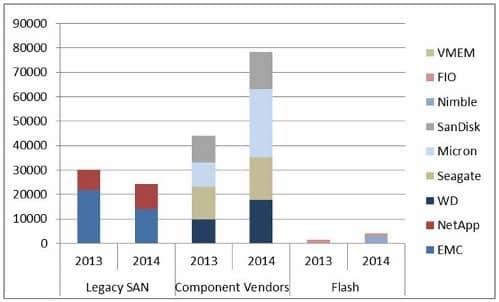By Bill Stevenson, executive chairman at Sanbolic If you are an equity investor in the enterprise storage market, you are probably asking yourself this question: do you bet on the new kids on the block such as Nutanix, Pure, Nimble, SimpliVity and Sanbolic? The value curve is indeed bending in favor of the new players […]
By Bill Stevenson, executive chairman at Sanbolic
If you are an equity investor in the enterprise storage market, you are probably asking yourself this question: do you bet on the new kids on the block such as Nutanix, Pure, Nimble, SimpliVity and Sanbolic?
The value curve is indeed bending in favor of the new players – especially for the enterprise storage component and flash vendors (see chart below). Who wins in 2014 will largely depend on the new players’ ability to attack the Tier 1 enterprise storage market – traditionally the purview of legacy array vendors.
Most of the new vendors are acutely aware of the need to move beyond narrow segments. Fusion-io saw tremendous growth on the strength of their sales into the data centers of Facebook and Apple (more than 50 percent of total sales) but then struggled to continue that growth across the broader enterprise market. Violin and IBM FlashSystem flash arrays are great for accelerating Oracle databases, but their challenge remains identifying and growing into new segments. Nimble has seen great reception for its hybrid arrays in SMB customers; they are now focused on cracking the enterprise code.
Legacy storage array vendors are acutely aware that the large public cloud data centers have long since moved away from their products. Facebook found that NetApp storage arrays were much too expensive when the number of photos being uploaded to their site exploded. As a result, Facebook built its own storage from commodity servers using Fusion-io flash cards and proprietary software. Google and Microsoft have taken similar approaches.
Most enterprise storage customers tend to be conservative, and only a few of them are likely to rip out their existing infrastructure and replace it with a brand new product. The data housed within those storage arrays is a core business asset that has to be highly accessible, protected and managed effectively. However, as the cost of housing that data has been growing exponentially, an increasing number of these traditionally shy enterprise customers are opening up to the possibility of weaving in new technologies around the edges, especially if such technologies offer the real promise of improved enterprise data management.
Enterprise Value in Billions of Dollars

Source: Data from 2/7/13 and 2/7/14. EMC EV net of 79.7% VMware stake. Source: Ycharts
So what will be required for flash appliances and software-defined storage to move into core Tier 1 and Tier 2 applications? They will need the following five must-have enterprise storage capabilities that result in real, disruptive economics and performance:
Few, if any, vendors meet all these requirements yet. It is hard to develop efficient scale-out technology quickly if the product was not initially designed to do so. It will be even harder to create disruptive economics by stuffing flash into an old storage array.
Dedicated storage controllers on commodity servers is the architecture used by most of the new flash storage system vendors, but the flexibility to run on converged compute/storage architecture will become increasingly important. Nutanix and SimpliVity are examples of this approach. We wouldn’t be surprised to see converged compute/storage become a core element of Cisco’s Unified Computing System.
The interesting question is how customers will choose to buy new storage technologies. Most are accustomed to buying a hardware box they plug in and then spend days or weeks configuring. At a recent Goldman Sachs conference, the CEOs of Nutanix and SimpliVity agreed that customers currently prefer buying an appliance, but that “software only” sales deployed on commodity hardware are likely to grow in the future. Given that storage is really about data architecture, not hardware deployments, will storage become a larger practice area for system integrators over the next few years? It could accelerate adoption in the Tier 1 accounts that legacy vendor are working to protect. In any case, a lot of change is coming.

Enterprise Storage Forum offers practical information on data storage and protection from several different perspectives: hardware, software, on-premises services and cloud services. It also includes storage security and deep looks into various storage technologies, including object storage and modern parallel file systems. ESF is an ideal website for enterprise storage admins, CTOs and storage architects to reference in order to stay informed about the latest products, services and trends in the storage industry.
Property of TechnologyAdvice. © 2025 TechnologyAdvice. All Rights Reserved
Advertiser Disclosure: Some of the products that appear on this site are from companies from which TechnologyAdvice receives compensation. This compensation may impact how and where products appear on this site including, for example, the order in which they appear. TechnologyAdvice does not include all companies or all types of products available in the marketplace.